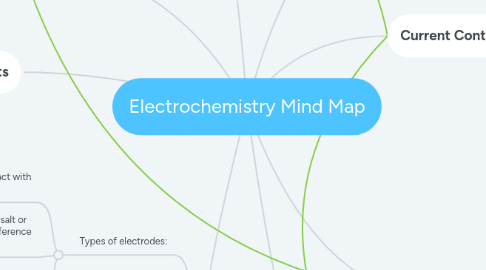
1. Voltage Control
1.1. The introduction of a varying voltage complicates cells.
1.1.1. But the use of a constant potential reference electrode allows the potential of the system to be calculated.
2. Measurements
2.1. Performed with a modified gibbs free energy equation, and the Nernst equation.
2.2. Working electrodes interact with the solution. Inert electrodes simple pass electrons along. Standard reference electrodes always maintain the same potential.
2.2.1. Reference electrodes can have their potentials calculated by the nernst equation.
3. Potentiometry
3.1. Types of electrodes:
3.1.1. First kind: Pure metal in contact with solution
3.1.2. Second kind: Metal that forms a salt or complex with anion. Usually a reference electrode
3.1.3. Third kind: Ion-selective electrodes, only permit the passage of certain ions, protons or sodium
3.1.3.1. The basis for the pH probe.
3.1.3.1.1. Measures the passage of protons.
3.1.3.1.2. Has an alkaline error from high pH values
3.2. Generally: Current is constant, zero, and potential is the only thing measured.
3.2.1. Occurs at phase boundaries of a cell where charge can accumulate.
3.3. Errors arise out of liquid junction potentials. The third kind electrode has three types of errors.
3.3.1. Type 1: Same salt different concentration
3.3.2. Type 2: One ion in common, same concentration
3.3.3. Type 3: All other combinations
3.3.4. Solved by looking at the charge and rate of diffusion for every ion in solution. The most mobile ion contributes the greatest imbalance of charge.
4. Amperometry
4.1. Current at working electrode is proportional to solute concentration
4.1.1. Used in oxygen and glucose monitoring
4.2. Works based on Faraday's law. (With some physical assumptions of known stoichiometry, and zero current loss.)
5. Current Control
5.1. Includes potentiometry
5.2. And the potential of half cells
5.2.1. Standard potential is a measure of voltage from a specific hydrogen platinum cell
5.2.2. Uses the equation Ecell = Eright - Eleft to determine spontaneity.
5.3. Is interested in galvanic(spontaneous) and electrolytic(non-spontaneous) cells
6. History
6.1. Luigi Galvani performed the first electrochemical experiment on the muscles of a dead frog in the 1700s
7. Voltammetry
7.1. Measures how current changes based on applied voltages
7.2. Must take into account faradic(associated with an electrochemical process) and non-faradic current (not associated with an electrochemical current.)
7.3. Steps are based on what reaction is happening at the electrode
7.3.1. The final stage, mass transfer, is based on diffusion away from the electrode, electrostatic charges moving away from the electrode, and convection
7.4. Methods
7.4.1. Cyclical: Varying scan rate
7.4.2. AC: Vary the AC frequency
7.5. Types of systems
7.5.1. Two electrode
7.5.1.1. Reference and working electrodes. Works with a small current
7.5.2. Three electrodes
7.5.2.1. Reference, working, and auxiliary electrodes. Reference electrode sees no change in current.
7.6. Steady state
8. Polarography
8.1. Identical to voltammetry, but with drops of mercury as the working electrode
8.1.1. Mercury is useful for large negative potentials, but is incapable of oxidizing due to its own ease of being oxidized.

